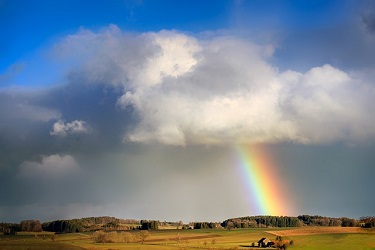
Not at all. I don’t have space to deal with the lyrics as a whole, so let me start with the opening phrase and go on from there. The lyricist himself, a son of Jewish immigrants who had taken the name of “Yip” Harburg, had been writing as a sideline while running a successful business which tanked in 1929. He said, “The capitalists saved me in 1929, just as we were worth, oh, about a quarter of a million dollars. Bang! The whole thing blew up. I was left with a pencil and finally had to write for a living… what the Depression was for most people was for me a lifesaver!”
Harburg’s specialty was lyrics that pined for a better tomorrow. “We worked for in our songs a sort of better world, a rainbow world,” he once said. “Now, my generation unfortunately never succeeded in making that rainbow world, so we can’t hand it down to you. But we could hand down our songs, which still hang on to hope and laughter… in times of confusion.” (both quotations from BBC Music: “Over the Rainbow—How this powerful song has soundtracked history”) The opening scenes of the movie are clearly set in the grim world of the Depression, with everyone so occupied with their work that no one has time to listen to Dorothy’s fears that Miss Gulch is going to take away her dog Toto. Aunt Em shoos her out of the way as she and Uncle Henry carefully count their chicks to see how many they still have after the old incubator has broken down. The three farmhands (who of course will show up as the Tin Man, Scarecrow, and Cowardly Lion in Oz) are busy, too. In exasperation Aunt Em says that Dorothy should “find yourself a place where you won’t get into any trouble.” Dorothy wanders off into the barnyard, saying to Toto, “A place where there isn’t any trouble. You suppose there is such a place, Toto? There must be. It’s not a place you can get to by a boat or a train. It’s far, far away, beyond the moon, behind the rain.” Then she launches into the song.
Before I go any further I feel I must point out that . . . there’s no rainbow up in the sky where Dorothy gazes as she sings. There’s an opening in the clouds and sunbeams streaming through, but no rainbow, at least not that I can see. No one seems to have noticed this but me, at least in the sources I’ve consulted. In reality a rainbow wouldn’t have shown up very well in the opening black-and-white scenes, so I guess they opted for the more easily-seen sunbeams.
But is the rainbow just a schmaltzy image? Actually no. The first mention of a rainbow comes in the Hebrew Bible book of Genesis, where God says to Noah after the flood,
Never again will all life be destroyed by the waters of a flood; never again will there be a flood to destroy the earth. I have set my rainbow in the clouds, and it will be the sign of the covenant between me and the earth. (9:11, 13 NIV)
We now know, scientifically speaking, that you can’t go “over” a phenomenon that’s made up of the color separation caused by light passing through water droplets, any more than you can find the “end” of it, but it’s fair to point out that the first mention of a rainbow is tied to a serious promise from God. So, all silliness aside, the image itself is pretty important, leprechauns and such notwithstanding. I wonder, by the way, if the Depression-era farm where Dorothy lives ever had many rainbows, since the setting would be in the middle of the severe drought that resulted in the Dust Bowl.
Let’s move on to the bluebird image. I had a vague idea (as many of my ideas tend to be) that a bluebird is a symbol of happiness, but I had no idea how old and how widespread the symbol is, going all the way back to ancient China and also showing up in Native American and Russian folklore. But the bird was made most famous in modern times by way of a symbolist play by Maurice Maeterlinck, The Blue Bird, drawn from an ancient French tale. The program notes from a 1912 London performance say, “The Blue Bird, inhabitant of the pays bleu, the fabulous blue country of our dreams, is an ancient symbol in the folk-lore of Lorraine, and stands for happiness.” (Wikipedia) Why a bluebird? I honestly don’t know. I will say, however, that the plot of Maeterlinck’s play seems to me to echo that of The Wizard of Oz. Both stories have a protagonist or protagonists who are looking for happiness, and in both stories the source of happiness is already with them, at home. Maeterlinck’s two children go on a search for the bluebird of happiness and return home empty-handed, only to find that the bird was in a cage there all along. Dorothy yearns for adventure, gets carried off to Oz, and only then realizes how much she wants to go home—which she could have done all along with her ruby slippers.
I hope I’ve convinced you that there’s a lot more to this song than you might have thought. And it was almost cut from the movie! Several people who were involved in the film, including Arthur Freed, the lyricist of “Singin’ in the Rain,” lobbied hard for it and in the end it was retained. But a reprise during Dorothy’s imprisonment in the Wicked Witch’s castle was cut. So sad! I guess we’ll just have to take what we can get.
Here’s the clip from the movie:
Here’s a good choral arrangement:
© Debi Simons


That is my favorite song thank you for your diving into it! Love Debi Wilden
Thanks, Deb! So glad you’re now following the blog.